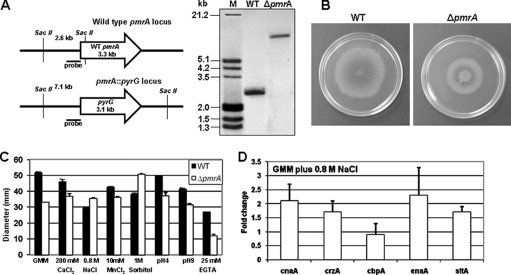Fig. 1.
Construction of the ΔpmrA strain and phenotypic analysis. (A) Schematic representation of the genomic locus of the WT and ΔpmrA strains. The entire coding sequence of the A. fumigatus pmrA gene was replaced with that of the A. parasiticus pyrG gene by homologous recombination. Southern analysis with SacII-digested genomic DNA and the pmrA left flank probe shows the replacement of pmrA with pyrG as a 7.1-kb fragment in the ΔpmrA strain. (B) Culture morphology of the WT and ΔpmrA strains on glucose minimal medium agar (GMM) after 5 days of growth at 37°C. (C) Radial growth of the ΔpmrA strain under different stress conditions, compared to that of the WT strain. A total of 1 × 104 conidia were inoculated onto GMM plates containing different salt concentrations. In addition, growth analysis was also performed on alkaline (pH 9.0) and acidic (pH 4.0) media. Three independent experiments were performed, and the results shown are the means and standard deviations obtained after 4 days of growth at 37°C. (D) RT-PCR expression analysis in response to salt stress. The expression levels of calcineurin catalytic subunit A (cnaA), a calcipressin (cbpA), a Na+ ATPase (enaA), and two zinc finger transcription factors (crzA and sltA) were analyzed after 20 min of exposure to 0.8 M NaCl. Three independent experiments were performed, and the results shown are the means and standard deviations.

